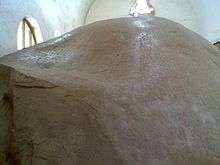Skandagupta
| Skandagupta | |
|---|---|
 Coin of Skandagupta period depicting himself | |
| 8th Gupta Emperor | |
| Reign | c. 455 – c. 467 CE |
| Predecessor | Kumaragupta I |
| Successor | Purugupta |
| Dynasty | Gupta |
| Religion | Vedic Hindu |
| Gupta Empire 320 CE–550 CE | ||||||||||||||||||||||||||||||||||
|---|---|---|---|---|---|---|---|---|---|---|---|---|---|---|---|---|---|---|---|---|---|---|---|---|---|---|---|---|---|---|---|---|---|---|
|
||||||||||||||||||||||||||||||||||
Skandagupta (Sanskrit: स्कन्दगुप्त) (died 467) was a Gupta Emperor of northern India. He is generally considered the last of the great Gupta Emperors.
Rule
Skandagupta's antecedents remain unclear. Later official genealogies omit his name, and even the inscriptions of his own age omit the name of his mother. Another contemporary record notes that the "goddess of sovereignty, of her own accord, selected him as her husband, having in succession discarded all other princes." This has been interpreted as suggesting that Skandragupta was the son of a junior wife.[1] It may even be that he was simply a successful general who promoted himself into the ruling Gupta clan.

He certainly faced some of the greatest challenges in the annals of the empire having to contend with the Pushyamitras and the Hunas (a name by which the "White Huns" were known in India). He defeated the Pushyamitras, a tribe who were settled in central India but then rebelled. He was also faced with invading Indo-Hephthalites or Hunas, from the northwest. Skandagupta had warred against the Huns during the reign of his father, and was celebrated throughout the empire as a great warrior. He crushed the Huna invasion in 455, and managed to keep them at bay; however, the expense of the wars drained the empire's resources and contributed to its decline. In particular, coinage issued under SkandaGupta is seriously debased.[2]
Skandagupta died in 467 and was succeeded by his half-brother Purugupta (467–473 CE), Kumaragupta II (473–476 CE), Budhagupta (476–495? CE) and Narasimhagupta, whose kingdom in the plains of Northern India was continuously attacked by the Hunas. Skandagupta's name appear in the Javanese text Tantrikamandaka, and Chinese writer, Wang-hiuen-tse refers that an ambassador was sent to his court by King Meghvarma of Sri Lanka, who had asked his permission to build a Buddhist monastery at Bodh Gaya for the monks traveling from Sri Lanka.
Coins of Skandagupta
Skandagupta issued four types of gold coins: Archer type, King and queen type, Chhatra type and Horseman type. His silver coins are of four types: Garuda type, Bull type, Altar type and Madhyadesha type.[3] The initial gold coinage was on the old weight standard used by his father Kumaragupta of approximately 8.4 gm. This initial coinage is quite scarce. At some point in his reign, Skandagupta revalued his currency, switching from the old dinar standard to a new suvarna standard that weighed approximately 9.2 gm.[4] These later coins were all only of the Archer type, and this standard and type was followed by all subsequent Gupta rulers.
References
- ↑ Majumdar, RC (1954), Chapter III: The expansion and consolidation of the Empire, in RC Maumdar, AD Pusalker & AK Majumdar (eds.) The History and Culture of the Indian People: [vol. 3] The Classical Age. Bharatiya Vidya Bhavan (1962), pp. 17-28.
- ↑ Majumdar, RC (1954), Chapter III: The expansion and consolidation of the Empire, in RC Maumdar, AD Pusalker & AK Majumdar (eds.) The History and Culture of the Indian People: [vol. 3] The Classical Age. Bharatiya Vidya Bhavan (1962), pp. 17-28.
- ↑ Agarwal, Ashvini (1989). Rise and Fall of the Imperial Guptas, Delhi:Motilal Banarsidass, ISBN 81-208-0592-5, pp.28-9, 31-2
- ↑ A.S. Altekar (1957). "The Coinage of the Gupta Empire", Varanasi: Banaras Hindu University.
- Agarwal, Ashvini (1989). Rise and Fall of the Imperial Guptas, Delhi:Motilal Banarsidass, ISBN 81-208-0592-5, pp. 210–8.
Further reading
- Singh, Jai Prakash (1976) History and Coinage of Skandagupta Kramāditya, Varanasi:Department of Ancient Indian History, Culture & Archaeology, Banaras Hindu University.
External links
- The Bhitari Pillar Inscription of Skandagupta
- The Bihar Stone Pillar Inscription of Skandagupta
- The Junagadh Rock Inscription of Skandagupta
- Coinage of Skandagupta
| Regnal titles | ||
|---|---|---|
| Preceded by Kumaragupta I |
Gupta Emperor 455–467 CE |
Succeeded by Purugupta |

